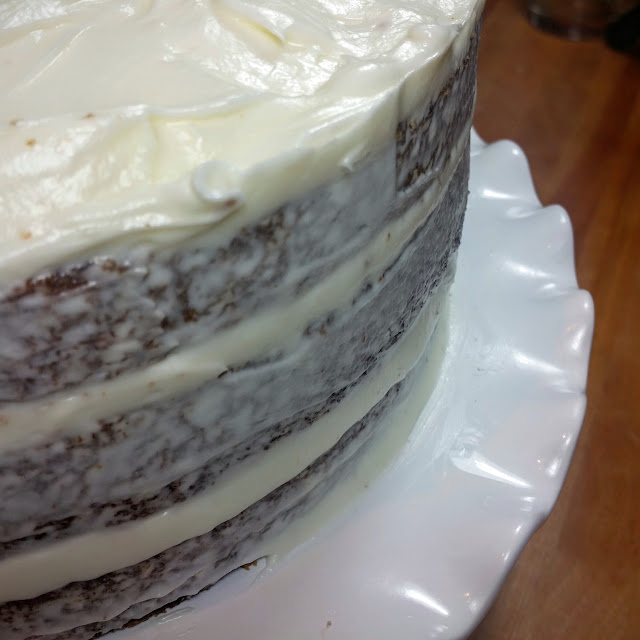I love carrot cake, it is by far my favorite of all cakes. Birthdays, anniversaries, just because, it's my go to. I try to avoid buying it if possible, especially from a supermarket, I find they tend to be far too sweet, and dry (but that's probably a good thing, or I'd be buying it every time I went shopping!). This recipe I've tweaked over the years, is simple, easy to follow, and it has worked every time. It makes a beautiful moist 3 tiered cake, which I like to frost 'naked', now some people when frosting in this way put no frosting at all on the sides of the cake, just between the layers and on top. I don't particular like this, as the sides exposed to air tend to dry out. So I like to go over the sides lightly with frosting, but you can still see the cake layers.
Ingredients
Softened butter, for pans
2 cups all purpose flour, plus extra for pans
1 cup sugar
1 cup light brown sugar
2 tsps baking soda
2 tsps ground cinnamon
2 tsps mixed spice*
1 tsp salt
1 1/2 cups vegetable oil
4 eggs beaten
3 cups of corsely grated carrots
½ cup golden sultanas, soaked in apple juice
1 1/2 cups chopped pecans
Frosting:
2 8oz packages cream cheese (room temperature)
1 stick salted butter (room temperature)
4 cups powdered sugar
Preheat oven to 350F, butter and flour 3 x 9" round pans, then line the bottom of the pans with parchment paper.
With the sultanas, I put them in a bowl, cover them in apple juice and microwave them for a few seconds, when ready to use I drain them off.
With the baking time, it seems quite presise, and this is for my main oven, with two pans just above the center and one just below center. I have a double oven, where the top oven is half the size of the main, I've found it takes a lot longer to bake in there, and I've had to eyeball it, so I recommend baking in the main oven if you have a double.
Once a toothpick just comes out clean, from the center of the cake, remove from the oven and let cool for 5 minutes.
To remove from the pans I carefully tip the cake upside down, gently onto my hand, then turn it back the right way up onto a wire rack, leaving the baking parchment on the bottom. Leave to cool completely.
While the cake is cooling, add the butter and cream cheese into a mixer bowl, and with the paddle attachment, beat the two together into a smooth mixture. Then add the powered sugar, a cup at a time, on a slow speed, that way it's less likely to create a cloud of sugar in your kitchen. Once all the sugar is added, you can turn the speed up and beat until it is light and fluffy. Then if you are like me you'll have refrain from eating the frosting before there's not enough for the cake, it's so simple, but so good.
Once the cake is complete cooled, remove the parchment paper, lay one of the cakes on a stand (or whatever else you'll be displaying your cake on) and top with 1/4 of the frosting. Repeat with the next two cake layers, then use the last 1/4 of the frosting to lightly cover the sides, if there is any left over I add this to the top.
All that is left to do now, is enjoy! Tea and cake anyone?
All that is left to do now, is enjoy! Tea and cake anyone?
*Mixed Spice is used in a lot of English cooking, and is absolutely wonderful






















































